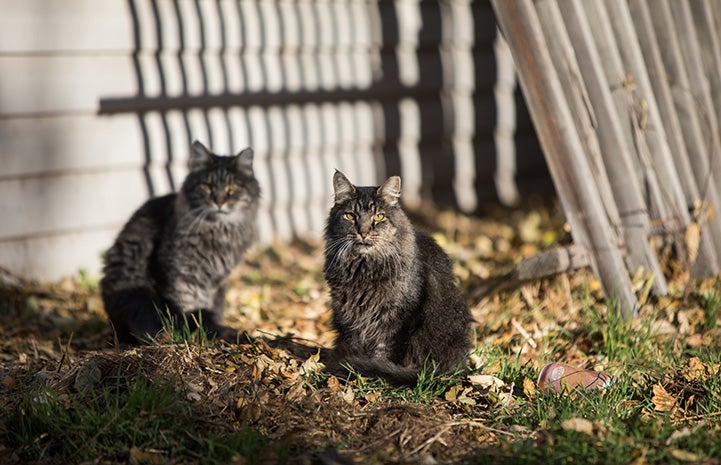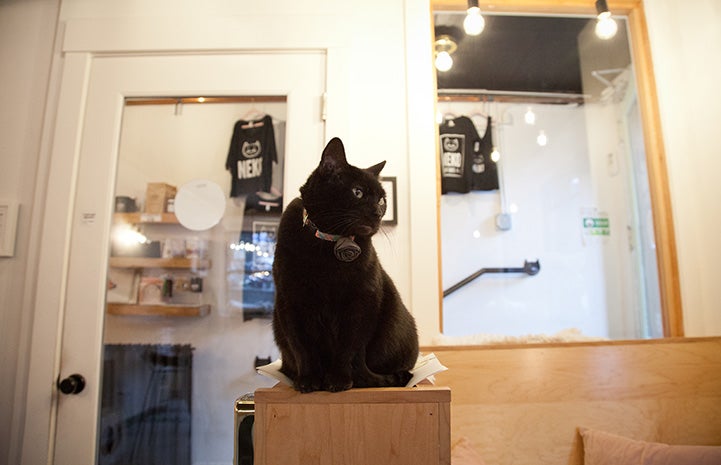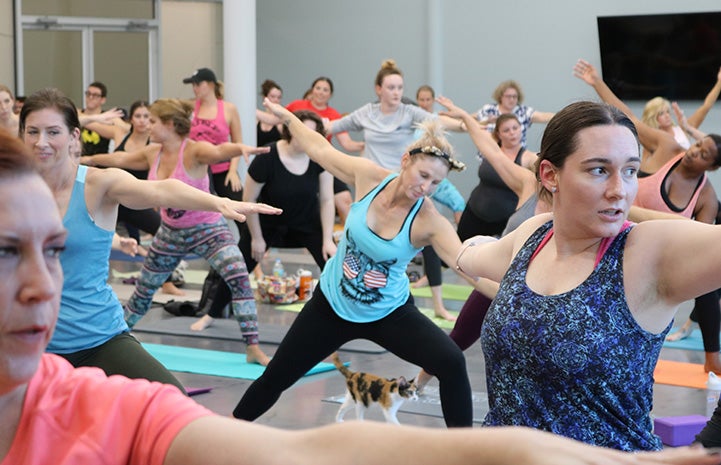Want to help save pets? Try thinking outside the kennel

For generations, most news stories about unwanted pets were steeped in guilt and sadness. It’s no wonder that millions and millions of animals were killed every year, and things weren’t looking up. Then, 35 years ago, the founders of Best Friends had an idea: Why not promote cats and dogs for adoption in a positive light, showcasing their wonderful qualities and emphasizing how good it feels to save a life? It was a radical notion, so different from the way things had always been done. Very few thought it would work, much less kick-start a lifesaving movement.
Innovative thinking in animal welfare has evolved a great deal since then. In fact, today Best Friends’ goal is to bring the entire nation to no-kill by 2025. Ingenious tactics are now saving thousands of lives. Fresh approaches to common challenges are emptying out shelters. Whole communities are enacting cutting-edge programs that improve save rates dramatically.
Turns out, it doesn’t take a creative mastermind, a big budget or a large team to create a seismic, lifesaving shift. All it takes is one brave person trying something new, and that person can be you.
Go ahead and think small
Many of us have felt stuck at some point, hoping for an epiphany that will allow us to save more lives more quickly. “Think outside the box,” people say. “Go in a new direction,” they advise. “Push the envelope,” we are told. If these phrases intimidate rather than inspire, how about this instead? Think small. Yes, small. Because even tiny changes can have an enormous impact.
In Virginia, something as straightforward as providing road trips to homeless pets is saving thousands of lives. High Five Virginia is a Virginia Federation of Humane Societies (VFHS) program that hosts a website and Facebook page for shelters to showcase their top-five priority animals to potential receiving organizations. And the program offers financial assistance — for vaccinations, heartworm medication or other expenses — to remove potential barriers to transfer.
Made possible in part by a Best Friends grant, High Five Virginia also helps out volunteers in the transport trenches. So, for example, after a road trip to pull at-risk dogs from a rural shelter and drive them to an urban shelter, volunteers can be reimbursed for gas money.
“Volunteers are doing this work with their own money, and some would help animals with their last dime. It brings tears to my eyes, what these citizens do,” says Debra Griggs, president of VFHS. “We give them $20 for gas and it keeps them humming and saving lives. We support them so they can expand their efforts and not go broke.”
In 2017, according to Debra, a total of 47,187 animals were saved in Virginia on account of transfers, thanks to the efforts of multiple organizations and individuals in the state. And in 2018, Debra says, High Five Virginia helped 3,051 animals with $10,715 in direct grants. That works out to only $3.50 per animal — less than the cost of a fancy coffee drink.
Going big to save cats in Kentucky
While there’s a lot to be said for the power of micro-change to alter the trajectory of outcomes, sometimes thinking big needs to be the order of the day. In 1999 in Louisville, Kentucky, the live release rate for cats at the municipal shelter was 0 percent (Yes, zero).
For obvious reasons, that didn’t sit well with Karen Little. Just as we all do when we see animals being killed needlessly, she realized that she had two choices: accept it or try something different. Karen and her husband decided on the latter, and ultimately created Alley Cat Advocates. She says, “My vision is long-term and bigger scale — how to help thousands of cats, not just one kitty that you’ve found on the street.”
The couple set out to create institutionalized change to help the entire population of community cats in Louisville. They did this by launching large-scale trap-neuter-return (TNR) efforts, partnering with the municipal shelter and riding along with animal care officers. Alley Cat Advocates also worked with council members, while building community support, to revise a harmful ordinance that required community cats to be killed if they weren’t adopted as indoor cats.
The new ordinance, which passed unanimously, mandates TNR and allows free-roaming cats to be returned to their neighborhoods after sterilization and vaccination.
The strategy worked. In 2018, according to Karen, Louisville’s feline live release rate was an astonishing 95.8 percent. And since 2000, Alley Cat Advocates has spayed or neutered more than 45,000 community cats.

The solution for your own area may be different from what Karen developed for Louisville. And that’s entirely OK. She suggests that you ask yourself a few simple but important questions: How do I want things to be? What do I want the world to look like? And how do we get there?
“If your vision is one of change,” Karen says, “you can’t continue to do the same thing and expect results to be different. You have to think big picture, and you have to realize that what’s been done isn’t cutting it. You get there by doing something different.”
Create a lifesaving community
It takes people working together to Save Them All, and creating a community of lifesavers sometimes requires ingenuity. Karen laughs when describing the clever way that Alley Cat Advocates does it: “I set things up so people stand in line at our spay/neuter clinics. It’s a strategic, simple solution.” While waiting, the cat caregivers start talking with each other and realize that they’re not alone, that they’re part of a proud community of compassionate people who can work together to effect change.
High Five Virginia is creating a different kind of community: one that connects volunteers, rescue groups and shelters across the state to save at-risk animals. On their website and Facebook page, shelters and rescue groups post photos and profiles of animals whose time is up, and other shelters with space and resources offer to take them.
Alice O’Connor, program manager for High Five Virginia, says this about the supportive community that has taken shape: “We see people using our Facebook platform saying ‘I have an adopter who wants a Great Dane. Who has one?’ And then a connection is made and a life is saved. Or ‘I have 25 spare kennels. Who needs them?’”
While it may be stating the obvious, community-building initiatives are having tremendous impact. According to Tammy Vanover Dotson, volunteer rescue coordinator for Wise County Virginia Animal Shelter, the shelter’s save rate was only 17 percent prior to 2014. But in 2017, it climbed to 90 percent, thanks in part to their participation in High Five Virginia.
“The High Five Facebook page is extremely effective. A shelter that we’ve never worked with will see one of our animals that we’ve posted and offer to take (him or her),” says Tammy. “High Five has been so wonderful. They offer connection and support, and we couldn’t do this without them.” In the past four years, Tammy says, her group – which consists of just five volunteers – has transported more than 7,500 dogs and cats, most of whom would have otherwise been killed.

Changing the game for homeless pets
Even the words we use can be game-changing. For example, regarding free-roaming felines, a simple change in vocabulary — such as using the term “community cat” instead of “feral cat” — encourages acceptance and humane management.
If you’ve come up with new ideas but face resistance from others, one little word can convince them to dip their toes into the waters of change. “‘Pilot’ is our most important word around here,” says Kristen Auerbach, director of Pima Animal Care Center (PACC) in Tucson, Arizona. “It makes it a lot less scary to start a new and innovative program. ‘Piloting a program’ is more palatable to people who may be nervous about trying it.” Another way to get around people’s trepidation about change is to propose a 30-day trial; all new ideas get a trial run for 30 days, and after that, as a team, you can re-assess.
Good thing Kristen figured out how to soften people up to the idea of change, because what she had in mind for PACC was nothing short of a colossal shift in traditional shelter operations. Recognizing that fostering saves lives immediately, makes animals more comfortable and alleviates strain on shelters, she and her staff dedicated themselves to refocusing operations around fostering.
In fact, they’ve created one of the largest municipal shelter fostering efforts in the country. Of the 17,000 animals admitted to PACC in 2018, more than 5,000 went to foster homes, according to Kristen. “With fostering, you’re turning the community into an animal shelter,” she says. “Right now, 800 of our animals are in foster care. Back in the day, they would have been killed for (lack of) space.”
In Washington state, Regional Animal Services of King County (RASKC) has taken a strategic approach to finding homes for a special segment of cats at the shelter — those with feline leukemia (FeLV). Not long ago, most shelters killed cats who tested positive for the virus.
Even though RASKC changed that policy several years back and FeLV-positive cats are now up for adoption, the staff recognized that some would sit in the shelter for weeks or months waiting for a home. Then NEKO, a coffee shop with a cat-loving, compassionate twist, offered to partner with the shelter, and RASKC asked if they could exclusively showcase their FeLV-positive cats at the café.

“It seemed like a crazy idea at first, since it hadn’t been done before, and we weren’t sure how the public would react, but we thought it was a great way to get more exposure for the FeLV cats and get them out of the shelter faster,” explains Nickie Ford, animal services coordinator for RASKC.
In addition to educating patrons about FeLV, the cats’ presence in the café resulted in 22 adoptions in 2018, according to Nickie. When it comes to innovative thinking, this is one café that goes far beyond enticing patrons with the added perk of biscotti.
How Quigley the cat found love at the Neko Café
Beg, borrow and steal
Don’t worry if ingenuity isn’t your thing. There’s no need to invent new ideas when you can simply borrow ones that have proven to be effective. Why reinvent the wheel, right?
When Jacksonville Humane Society (JHS) wanted more people to come through their doors and give their difficult-to-place cats additional exposure, they started monthly yoga classes with cats at the shelter. Participants love it, cats get adopted, and they garnered $6,000 in donations in just six sessions. “I’m not going to lie. We absolutely stole that idea,” says JHS’s CEO, Denise Deisler, with a laugh. “Several of us on staff are voracious Facebook readers. It’s a great place to get ideas.”

JHS has also borrowed the concept of offering a program in which children read to pets. Kids come to the shelter and read to adoptable animals, providing a two-way benefit — the kids improve their reading skills and the pets enjoy socializing — that has been a winner at other shelters. It’s now one of JHS’s most popular programs and regularly attracts families while increasing adoptions and donations.

“It’s all about engaging people in an unconventional way and bringing the community in. If something works for another group, it may work for you, too. So look around at what others are doing, call and talk with them, and don’t be afraid to give their programs a try,” suggests Denise.
How yoga helps homeless pets, too
A lesson from Best Friends founders: think differently
Since the 1980s, Best Friends has pioneered lifesaving strategies, despite resistance from change-averse traditionalists. Showcasing pets with special needs as adoptable was once thought to be a hopeless waste of time. Housing cats together in comfortable home-like spaces was considered dangerous. And helping shelters across the country, rather than demonizing them, once made waves.
But Best Friends’ most radical, controversial idea was simply this: Let’s not kill animals. Today, as the commitment to lifesaving gathers momentum across the country and people rise to the challenge with innovative approaches, saving them all doesn’t sound so radical after all.
This article originally appeared in Best Friends magazine. You can subscribe to the magazine by becoming a Best Friends member.
Photos by Tammy Vanover Dotson, Sarah Ause Kichas, Nickie Ford and courtesy of the Jacksonville Humane Society